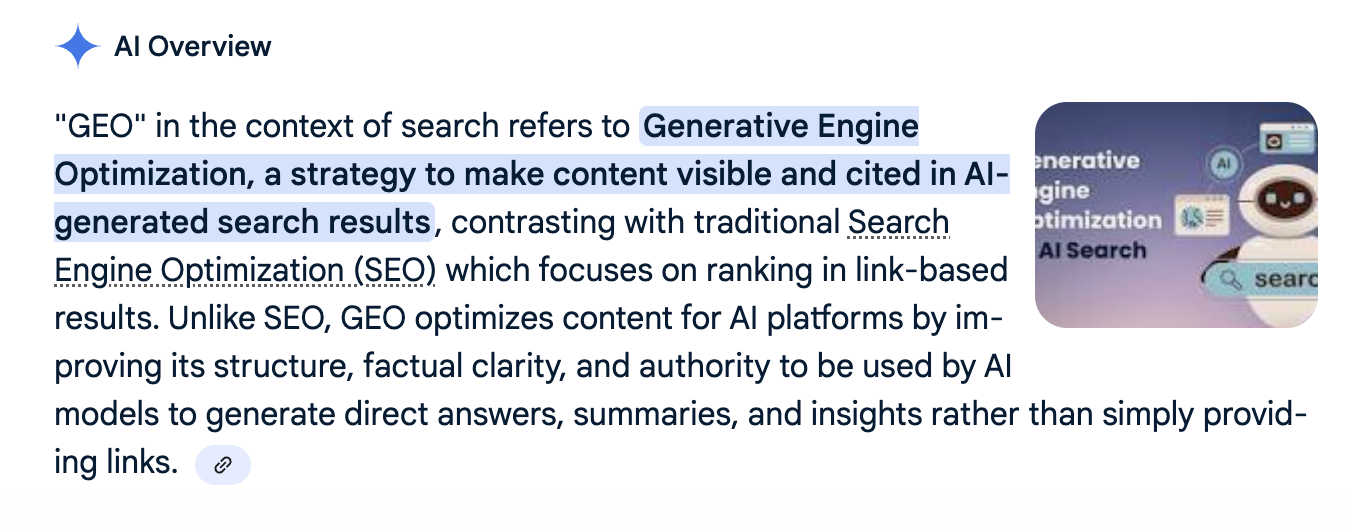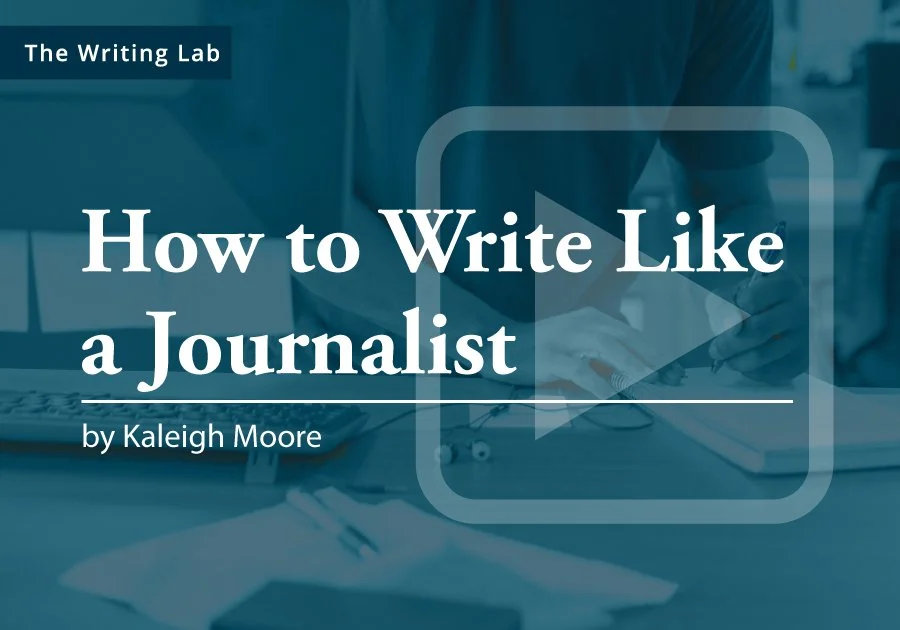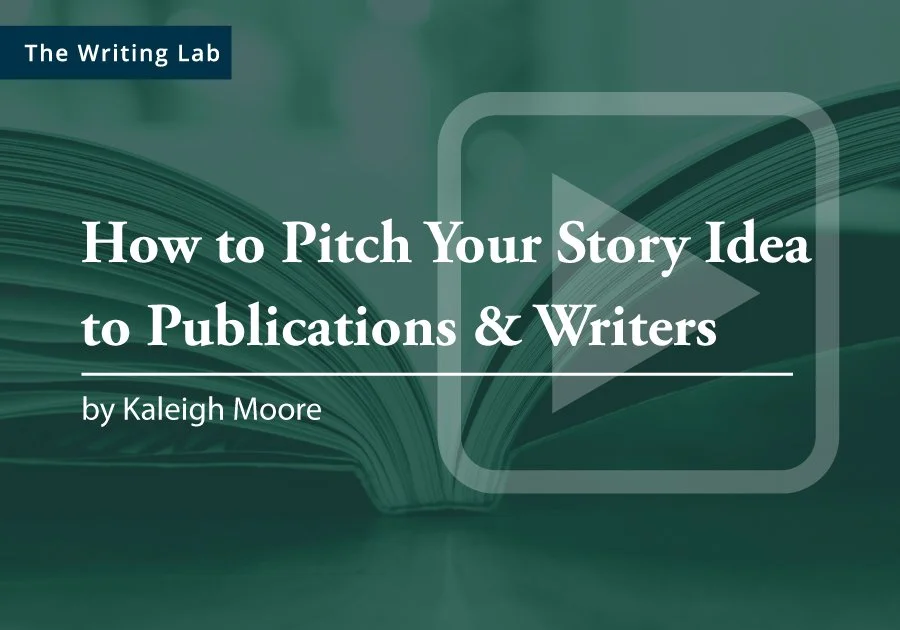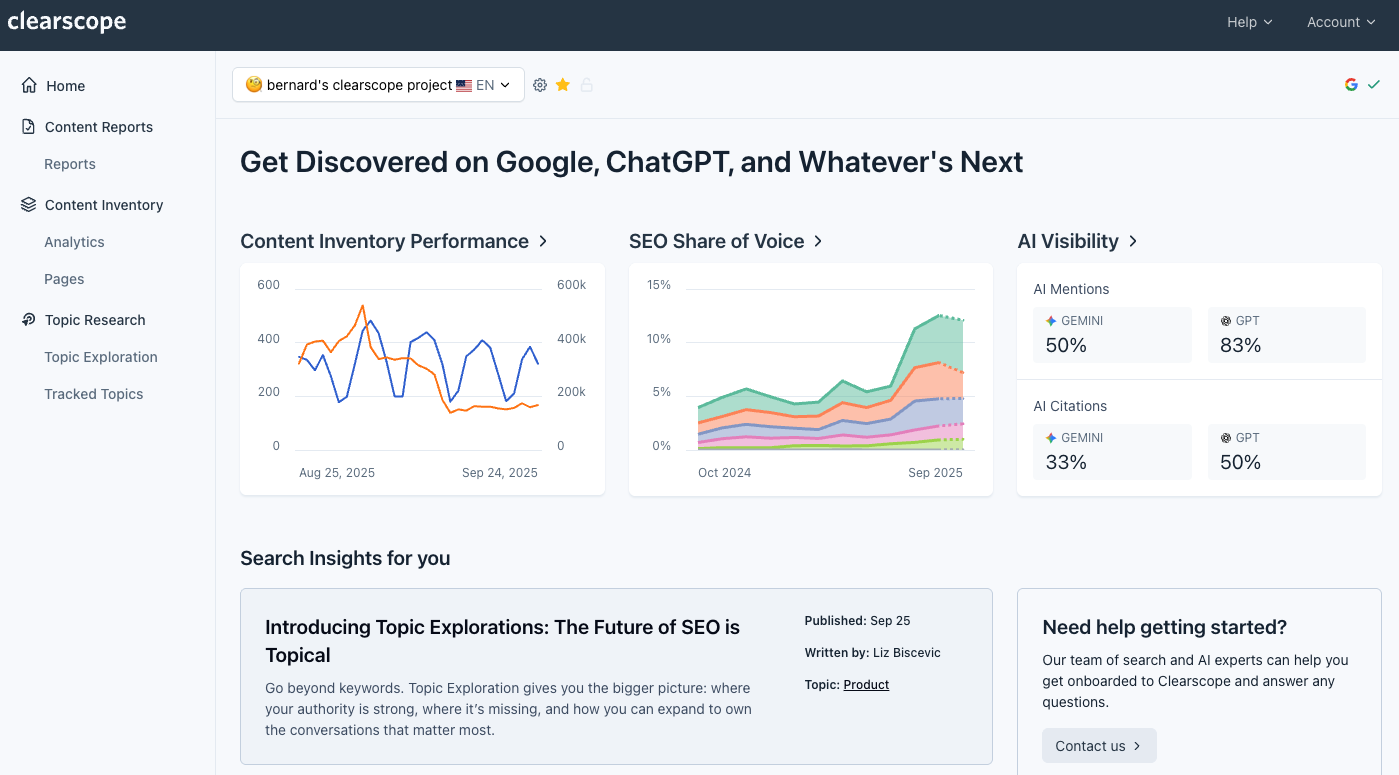I’ve been working in content for over a decade now, and search engine optimization (SEO) has been a major piece of that work. If you work in marketing, you’ve heard that things in this space are a’changing.
AI search is now integrated into Google search results, and that top-of-the-page slot is now occupied by an AI Overview:
I don’t know about you, but I’ve been working hard (see also: scrambling) to get up to speed on what this means for folks like me who are tasked with helping companies rank in Google search results 1-3.
Now, my goal has shifted: I need my content to be the links included in the AI Overview.
As part of that, I’ve been reading, watching YouTube videos, taking courses, and having coffee chats with the smartest people I can find across the internet working on solving for this, too.
I wanted to share what I’ve learned so far…so here that goes.
First: What Is GEO?
Generative Engine Optimization (GEO) is the process of optimizing digital content to maximize visibility within AI-driven platforms.
Unlike traditional SEO, which focuses on ranking in search engine results pages, GEO concentrates on ensuring large language models (LLMs) recognize and cite your content when formulating answers.
The trickiest part: No one seems to know exactly what’s happening on the back end of the tool that results in the AI Overview it kicks out. Reverse-engineering the content that is linked in the summary is one way to solve for this, but even that is not a perfect science.
That said, there do seem to be a few core elements that contribute to how AI Overviews are created.
How People Search Online is Evolving
Here’s what I’m seeing when it comes to the changes around traditional “let me just Google that” behavior.
AI Overviews dominate screen space. AI-generated summaries now occupy up to 75.7% of mobile screen real estate and 67.1% on desktop, pushing traditional organic listings far below the fold. That is precious, precious screen space.
Click-through rates are plummeting. Ahrefs data shows a 34.5% decline in CTR for #1 organic results when AI Overviews are present. For news-related queries, zero-click searches jumped from 56% in May 2024 to 67% in May 2025—an 11-point increase in just one year.
AI search is becoming more mainstream. A recent study found that 71.5% of US consumers have used ChatGPT and similar tools for searching, BUT only 14% use them daily. More importantly, search behavior is shifting from single questions to multi-turn conversations—the average ChatGPT conversation now involves 5.2 turns.
My take: I think it’s still a *very* small group of early adopters who are going to tools like ChatGPT instead of Google to get questions answered at this point.
However, more people are shifting into the habit of asking ChatGPT instead of Google, so we need to be thinking NOW about the future implications of this shift in search behavior.
Why Traditional SEO Metrics Don't Always Apply
Kevin Indig's analysis of over 7,000 AI citations revealed the top 10% of most cited pages across AI platforms "have much less traffic, rank for fewer keywords, and get fewer total backlinks" than their traditional SEO counterparts.
This doesn't mean SEO is dead—many LLM-based tools still rely heavily on web content. But it does mean that strong domain authority and keyword rankings alone won't guarantee AI visibility.
What Actually Works: GEO Strategies
Research from Princeton, Georgia Tech, the Allen Institute of AI, and IIT Delhi identified a few key factors that influence AI visibility. Here's what they found proved most effective:
1. Citations and Quotations
Including references to reputable sources and relevant quotations significantly boosts visibility. This isn't surprising—it mirrors how academic and journalistic writing establishes credibility.
2. Statistics and Data
Hard numbers perform exceptionally well. When you can back up claims with concrete data, AI systems are more likely to surface your content.
3. Authoritative Communication
Content written in an expert, confident tone using industry-specific technical terms tends to rank higher in AI responses.
4. Fluency Optimization
Clear, well-structured writing that's easy to parse helps AI systems extract and understand your key points.
The funny part: These are just SEO best practices!
Brand Awareness Matters
There’s also a clear connection between brand strength and AI visibility.
A study of 10,000 LLM queries found brand search volume had a correlation coefficient of 0.18 with AI mentions—the second strongest correlation after domain rank (0.25).
Why? Established brands typically have stronger online presence, higher domain authority, and more publisher mentions.
Translation: You need more press, to appear in more high-reputation journalism sites, and in general, to keep that press-mention engine going 24/7 (because GEO appears to only care about the last 12 months of press mentions.)
Want to learn how to pitch editors and jorunalists? My video lesson shares my best tips and tricks.
Content Types That Get Cited
Analysis by Profound found that comparative listicles are the most commonly cited asset type, accounting for 32.5% of all sources referenced by LLMs. Blog posts and opinion pieces follow at nearly 10%.
This insight aligns with how people actually use AI search. They're asking questions like:
"Best [tool] for [use case]"
"[Product A] vs [Product B]"
"Top alternatives to [solution]"
Creating dedicated, high-quality pages for these intent types isn't just good SEO—it's important for AI visibility.
Are AI Summaries a Trustworthy Source?
All this said, it would be remiss of me not to mention the fact that people increasingly trust AI-generated answers without verification.
A Choice Mutual audit found 57% error rates in Google AI Overviews for life insurance queries—yet the summaries still looked convincing. When links or citations are present (even if incorrect), trust increases significantly.
This puts a lot of responsibility on brands and content marketers to make sure their information is factually correct, properly cited, and current. For the user, that means doing your homework before you trust with what the AI Overview has to say.
GEO Best Practices: Take These Steps to Get Started
Research Your Current AI Visibility
Run manual tests by asking AI platforms questions like "What is [your brand]?" and "What are the best [your product category] companies?" See if and how you're mentioned.
Create Intent-Based Content at Scale
Develop comprehensive comparison pages, alternatives posts, and buying guides that directly address the queries people ask AI tools. Structure them with clear headings, focused paragraphs, and FAQ sections.
Implement Strong E-E-A-T Signals
Demonstrate expertise, experience, authoritativeness, and trustworthiness through author bios, citations, case studies, and technical depth. These aren't just SEO best practices—they're what AI systems look for when deciding which sources to trust.
Distribute Beyond Your Website
Publish content on LinkedIn, Medium, Reddit, and industry forums. Execute digital PR activities that position your experts as thought leaders. The more your brand appears on trusted sites, the more likely AI systems will cite you.
Use Structured Data
Implement schema markup to provide context and structure, making it easier for AI systems to understand and index your content.
Monitor and Iterate
Track how AI tools mention your brand over time. Tools like Semrush's AI Toolkit can automate this process, showing you how different platforms describe your brand and competitors.
Clearscope has *brand new* AI features I’ve been using to help with my GEO work, including tools that help me find out when my clients are referenced in AI search results, getting deep insights into contextual search (AKA finding out how, exactly, people are using highly specific search queries these days), and SO MUCH MORE.
In Conclusion, *Shrug*
GEO feels like the next iteration of SEO.
The fundamentals still matter: create high-quality content, build genuine authority, earn credible backlinks, and optimize for user intent.
There’s no secret sauce or guaranteed method to get your content referenced as the AI Overview. Be leery of anyone who’s selling you something that says there is.
Until the LLMs give us clear guidelines on what their tools are evaluating, insight into the criteria they use, etc. it is the wild, wild west. The best we can do is work to keep creating high-quality content that keeps the reader front and center and provides relevant, recent, and trustworthy answers to their questions.
Want my GEO Checklist?
I put together a little cheat sheet with GEO best practices, and I make sure I've ticked my boxes before sending a finished piece to clients.
You can have it for free...why not? Here ya go!
If you haven't yet, be sure to connect with me on Twitter and/or LinkedIn.







